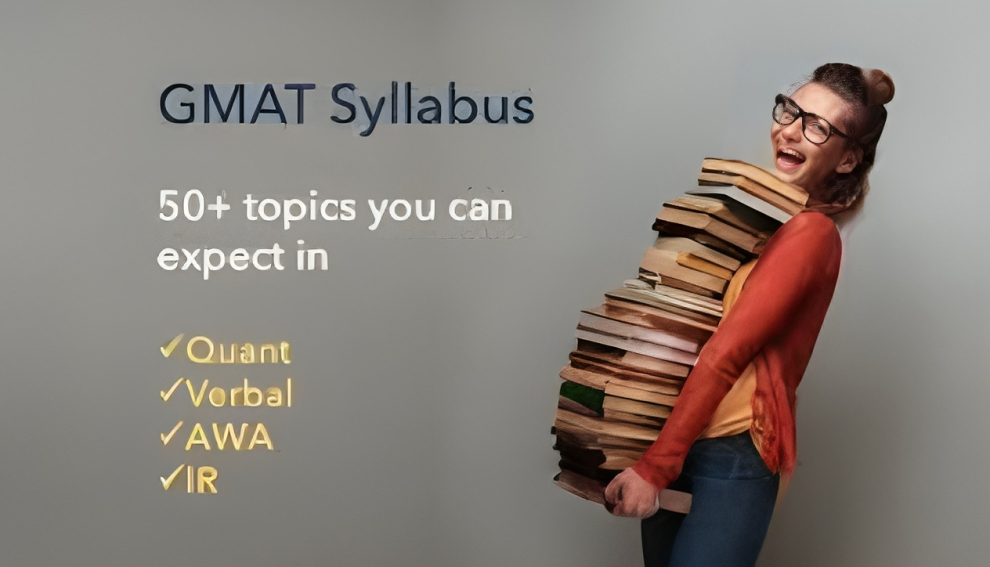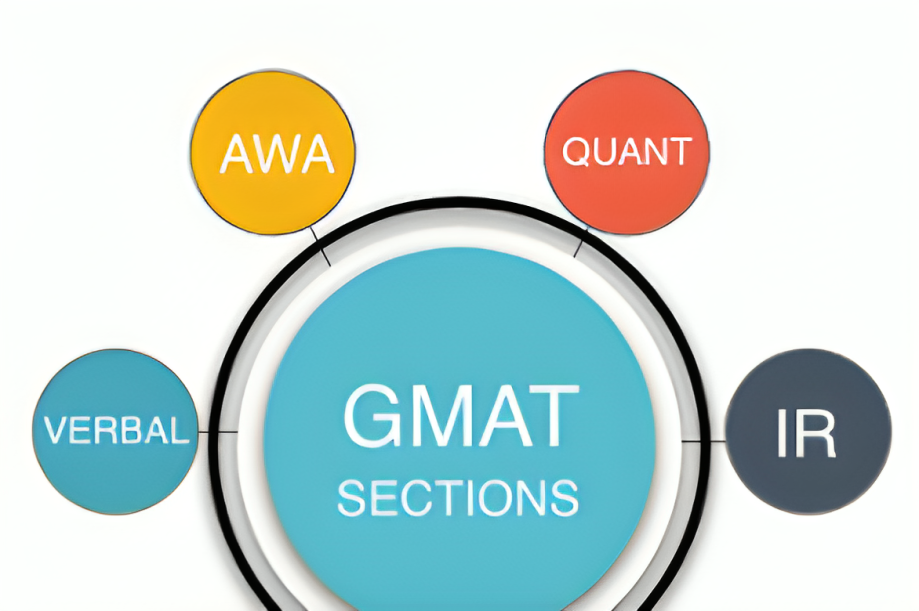There are basically four sections in the GMAT syllabus: Quantitative, Verbal, IR, and AWA. There are a total of 80 questions on the GMAT exam syllabus. The GMAT exam pattern has a 3-hour, 7-minute time limit, and scores range from 200 to 800. The GMAT exam design and syllabus have undergone some adjustments thanks to the Graduate Management Admission Council (GMAC), but they will remain in place through the end of the third quarter of this year. Through these parts, the GMAT syllabus 2023 evaluates students’ analytical and reasoning abilities.

GMAT Syllabus 2023
| GMAT Section | Question Types | Number of Questions | Timing |
|---|---|---|---|
| GMAT Quantitative | Problem Solving, Data Sufficiency | 31 questions | 62 minutes |
| GMAT Verbal | Sentence Correction, Critical Reasoning, Reading Comprehension | 36 questions | 65 minutes |
| GMAT Integrated Reasoning | Table Analysis, Graphics Interpretation, Multi-Source Reasoning, Two-Part Analysis | 12 items | 30 minutes |
| GMAT Analytical Writing Assessment (AWA) | Analysis of Argument | 1 topic | 30 minutes |
GMAT Syllabus for Quant Section
Given the large number of applicants with backgrounds in the humanities, the GMAT’s Quant part does not require any knowledge of mathematics beyond that taught in high school. There are two main question categories on the GMAT quantitative syllabus:
GMAT Problem Solving with approximately 18-20 questions and tests the algebra, geometry, and arithmetic sections. Problem-solving questions in GMAT measure skills and how well the test takers solve any critical situation with rational approaches.
The GMAT Data Sufficiency exam consists of 11–13 questions and includes a problem with two statements. The test taker must determine whether the presented statement is sufficient to address the issue in the question. A few preparation strategies for the data sufficiency GMAT curriculum of the MBA include the elimination technique, answering the problem, and individual sufficiency.
| Arithmetic | Algebra | Geometry |
|---|---|---|
| Number Systems & Number Theory Multiples and factors Fractions Decimals Percentages Averages Powers and roots Profit & Loss; Simple & Compound Interest Speed, Time & Distance Pipes, Cisterns & Work Time Ratios and Proportions Mixtures & Allegations Descriptive statistics Sets Probability | Permutation & Combination Monomials, polynomials Algebraic expressions and equations Functions Exponents Arithmetic & Geometric Progression Quadratic Equations Inequalities and Basic statistics | Lines and angles Triangles Quadrilaterals Circles Rectangular solids and Cylinders Coordinate geometry |

GMAT Syllabus for Analytical Writing Assessment
The GMAT syllabus of AWA tests the candidate’s essay writing skills as a response to an argument. You’ll write a response, typically 4 to 6 paragraphs, in which you evaluate the argument. The logic over here is to check your ability to think critically about opinions presented to you. Analyzing the information as well to determine what information might help you further evaluate the argument in more depth.
The following are useful in the Analytical Writing Assessment section of GMAT:
- Brainstorming
- Writing an introduction
- Writing body paragraphs
- Concluding your essay
The GMAT syllabus can ask two types of essays
1. You must first assess the rationale for your position before presenting it in an argument essay. Everything will depend on how persuasively you can support your claim.
2. You must compose an essay on the issue that has been assigned to you for the Issue Essay portion. It should be roughly 600 words long, and either the candidates’ own opinions or those that support the stated position may be expressed.
GMAT 2023 Syllabus for Verbal Section
The GMAT Verbal syllabus evaluates the test-takers’ capacity to comprehend and analyze the provided extract in order to respond to the provided questions. This part is necessary to ensure that English is being used as effectively as possible.
The verbal reasoning section of the GMAT syllabus consists of three types of questions:
- Answer three or four multiple-choice questions based on what you learned from a short (200–300 words) or lengthy (300–400 words) passage in a reading comprehension test. Reading comprehension skills such as inference, application, primary idea, supporting the idea, logical structure, and style will be examined.
- Critical Reasoning questions set forth an argument that you then analyze which measures your skill to make arguments, evaluate arguments, and formulate or evaluate a plan of action. There are eight different types of CR questions, all of which are multiple-choice. The major question types tested are:
- Assumption
- Strengthen/Weaken
- Evaluate
- Identify the Reasoning
- Flaw
- Inference
- Resolve /Explain
3. Sentence Correction You are given a sentence in sentences that needs to be corrected. The underlined portion of this sentence asks you to determine whether it contains a grammatical error. If that’s the case, you can select one of four options for the underlined text. regular grammar examinations include
- Subject-verb agreement
- Verb tense
- Pronouns
- Parallelism/Comparison
- Idioms
- Misplaced Modifiers
With GMAT Verbal Books, applicants obtain a good amount of verbal practice questions and ideas to clear on the GMAT verbal syllabus, which may be completed by practicing several GMAT verbal sample papers, thoroughly reading 40 to 50 pages each day, and acquiring vocabulary from flashcards.
GMAT Syllabus for Integrated Reasoning Section
The newest section of the GMAT syllabus is Integrated Reasoning. The candidates’ capacity to assess data provided in graph or table format is tested in this segment. There are 12 questions of the following kind in this section:
Table Analysis:
This section measures candidates’ ability to sort and analyze a table comprising data, like a spreadsheet, to determine the important information or the one that meets certain conditions.
Two-Part Analysis:
Measures the candidates’ skills to solve complex problems. The problems can be verbal, quantitative, or a combination of both. The format is versatile and covers a wide range of content. The candidates’ ability to solve simultaneous equations, evaluate trade-offs, and discern relationships between two entities is measured.
Multi-Source Reasoning:
It measures candidates’ skills to examine data from multiple sources tables, graphics, text passages, or a combination of all three, and analyze each source of data carefully to answer multiple questions. The candidates will be asked to draw inferences and others may require you to determine whether data is important. In a few questions, candidates will have to recognize discrepancies among different sources of data.
Graphics Interpretation:
It measures candidates’ ability to interpret the information presented in a graph or graphical image (scatter plot, x/y graph, bar chart, pie chart, or statistical curve distribution) to find out relationships, and make inferences.
GMAT Syllabus 2023 Preparation Tips
You need a few solid GMAT books and resources, as well as study material, motivation, and self-discipline, to be able to study independently and successfully. The preferable choice, however, is to enroll in a GMAT coaching center near you if time is a factor and you feel the need for professional help to ensure a competitive edge in GMAT exam preparation.
It’s not difficult to finish the GMAT course in three to six months. The following advice can assist you in organizing your GMAT course preparation:
- Understand the GMAT exam syllabus and pattern thoroughly.
- Make sure to start your preparation with the official GMAT study material, which includes the GMAT OG. Official study material must be the base and the starting point of your preparation.
- Once you complete the official study material, you can move on to Manhattan Prep GMAT guides. They are an authentic source of GMAT preparation. In addition, you may consult other sources such as Veritas, Magoosh, etc.
- Make sure that you visit the GMAT Club and Beat the GMAT forums on a regular basis. You can find practice questions, B-school reviews, toppers’ experiences, etc.
- Appear for multiple GMAT mock tests. It will help you gauge your preparation levels and progress.
How to Prepare GMAT Syllabus for MBA?
The score needed to achieve the desired percentile can be estimated using the CAT Cut off marks vs. percentile analysis. Marks above 100 can get you a CAT Cut off percentile above 99 based on patterns from the prior year.
In order to prepare the GMAT syllabus for MBA, students typically require 3-6 months (average 4 months). The table given below provides a 4-month plan to cover the GMAT exam syllabus:
| Month | GMAT Syllabus Preparation Strategy | GMAT Books |
|---|---|---|
| Month 1 |
|
|
| Month 2 |
| |
| Month 3 |
| |
| Month 4 |
|
FAQ's
The material that will be covered on the GMAT exam is outlined in the GMAT curriculum. Verbal Reasoning, Quantitative Reasoning, and Analytical Writing Assessment are its three divisions. A list of available resources for studying is also included in the syllabus.
Comparing relative difficulty, is the GMAT simpler than the CAT? The GMAT syllabus and question types are very clearly specified, making GMAT preparation simpler than CAT preparation. With 90 to 120 hours of focused study, it is feasible to achieve a GMAT score of 700 or above.
As we’ve seen, to score 750+ on the GMAT, you have to get almost all the medium-difficulty questions in the Quant and Verbal sections of the test correct. Also, you need to get some hard questions correct. To perform at that level when taking the test, you need to achieve very high accuracy when practicing.
The GMAT registration deadlines vary depending on the test date. You can find the deadlines on the GMAT website.




















